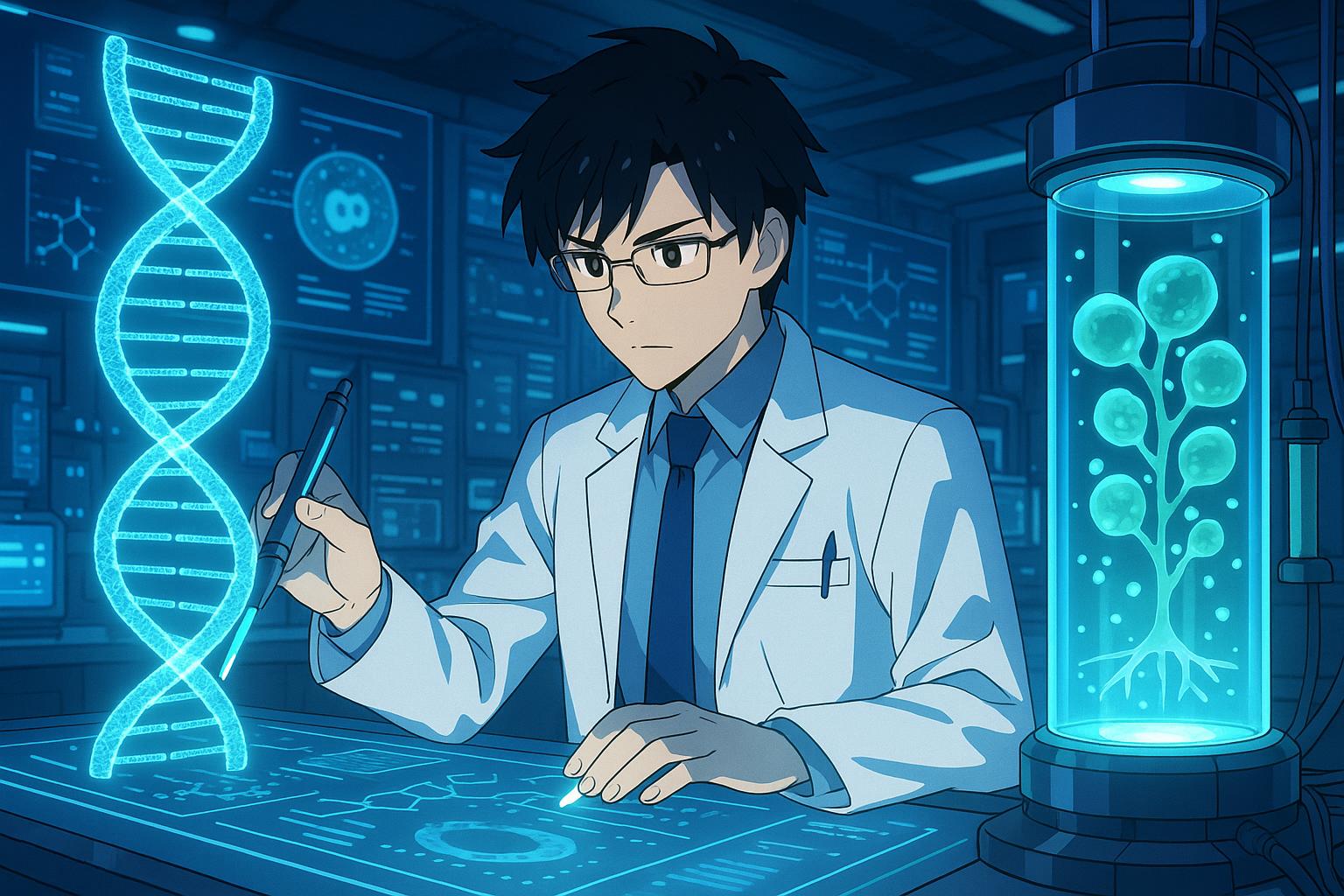Breakthroughs in placental stem cells, CRISPR gene editing, senolytic treatments and AI-driven personalised medicine are accelerating progress towards longer, healthier lives despite ethical and clinical challenges.
In recent years, advancements in technology aimed at extending human life and enhancing health have gained significant momentum. While achieving radical life extension beyond the natural limits remains an ambitious goal, several innovative developments promise not only to improve longevity but also to elevate the quality of life. This exploration delves into the various technologies that are actively confronting aging and age-related diseases.
Regenerative medicine stands at the forefront, focusing on the renewal of damaged tissues and organs. Notably, the company Celularity claims that its research into placental stem cells has led to a remarkable 30% increase in lifespan for animals, achieved through the regeneration of tissues. This burgeoning field is complemented by findings that suggest blood stem cell diversity diminishes after the age of 50, increasing susceptibility to diseases. Researchers are turning their attention to potential therapies that could mitigate these effects and restore youthful functionality.
Senolytic therapy is another groundbreaking approach, targeting senescent cells—those that contribute to inflammation and age-related decline. Unity Biotechnology has centred its efforts on developing treatments for ailments like osteoarthritis, thereby proposing a significant enhancement in life quality for older adults. Additionally, recent discussions explore the potential for engineered T cell therapies to combat aging-related diseases by eliminating these problematic cells, hinting at a future where targeted genetic interventions could revolutionise how we manage health in later years.
Advancements in genetic engineering also play a pivotal role in the quest for longevity. Technologies such as CRISPR provide researchers with tools to precisely edit genetic codes associated with aging. For instance, a team at Harvard has demonstrated how gene therapy can protect against heart failure and diabetes in mice, signifying a promising pathway for human applications. Coupled with these insights, research into the rejuvenation of aging stem cells through CRISPR-Cas gene editing holds substantial promise for enhancing stem cell functionality and longevity across biological systems.
Further contributing to longevity strategies, pharmacological innovations reveal compelling results. Studies show that a combination of lithium, trametinib, and rapamycin has extended lifespans by up to 48% in animal models. With ongoing research exploring similar pharmacological interventions, there is hope for translating these findings to human applications, particularly as scientists uncover more about drug interactions and their long-term effects on the aging process.
Personalised medicine, bolstered by artificial intelligence, significantly enhances early diagnosis and bespoke treatment plans. AI technologies analyse vast datasets to predict health trajectories, facilitating timely interventions. Moreover, innovations such as the da Vinci surgical robot have improved surgical precision, while smart sensors deployed by startups enable more effective disease diagnostics, fundamentally changing the landscape of healthcare.
The advent of 3D bioprinting technology also shows promise in addressing the growing organ shortage crisis. By creating tissues and organs, 3D bioprinters could democratise transplant accessibility, enhancing survival rates and life quality for those with organ failures. Alongside bioprinting, cryonics—the process of preserving tissues at extremely low temperatures—has evolved as researchers refine cryoprotectants and thawing methods in hopes of achieving future restorability.
However, while the market for anti-aging technologies is projected to soar to $610 billion by 2025, challenges still loom. Aging is not universally acknowledged as a disease, which hampers research opportunities and funding. Additionally, ethical concerns and the need for robust clinical trials continue to pose significant hurdles, delaying the widespread implementation of these transformative technologies.
Yet, as contemporary strategies such as gene therapy, senolytics, and AI begin to display tangible improvements in quality of life, there’s a palpable sense of optimism. The confluence of these innovations points toward a future where achieving a long and healthy life may become more than a mere aspiration—it may very well be a reality.
Reference Map:
- Paragraph 1 – [1], [2]
- Paragraph 2 – [1], [2], [5]
- Paragraph 3 – [3], [6]
- Paragraph 4 – [1], [6], [7]
- Paragraph 5 – [3], [6]
- Paragraph 6 – [1], [4]
- Paragraph 7 – [1], [6]
- Paragraph 8 – [1], [2]
- Paragraph 9 – [1], [7]
Source: Noah Wire Services
- https://baku.ws/en/this-is-interesting/what-technologies-are-extending-life-right-now – Please view link – unable to able to access data
- https://www.ft.com/content/a1f83886-fb29-4f5f-9577-bec61dfd31d2 – This article discusses recent scientific breakthroughs in understanding human blood aging and limb regeneration. Researchers have uncovered how blood stem cells become dominated by specific clones after age 50, reducing diversity and increasing disease vulnerability. Additionally, a study on Mexican axolotl salamanders reveals that the gene Hand2 guides limb regrowth, suggesting potential for future tissue regeneration in humans. These findings highlight advancements in regenerative medicine and biological aging, potentially guiding future personalized anti-aging and regenerative therapies. ([ft.com](https://www.ft.com/content/a1f83886-fb29-4f5f-9577-bec61dfd31d2?utm_source=openai))
- https://www.cellandgene.com/doc/crispr-cas-genome-editing-for-rejuvenation-of-aging-stem-cells-0001 – This article explores the potential of CRISPR-Cas genome editing technology in rejuvenating aging stem cells. It discusses how CRISPR-Cas can directly edit genetic and epigenetic changes in stem cells, potentially restoring or enhancing their function. The piece also highlights the promise of this technology in treating age-related diseases by improving stem cell health and function, opening new therapeutic avenues and extending the quality of life for older adults. ([cellandgene.com](https://www.cellandgene.com/doc/crispr-cas-genome-editing-for-rejuvenation-of-aging-stem-cells-0001?utm_source=openai))
- https://en.wikipedia.org/wiki/Biohybrid_system – This Wikipedia article provides an overview of biohybrid systems, which integrate living cells with synthetic materials to create functional devices. It discusses the challenges and limitations of biohybrid systems, including ethical and biomedical concerns, cell sourcing issues, and long-term viability. The article also explores future directions, such as self-regulated organ substitutes and regenerative implants, and potential applications in wearable biohybrid systems for rehabilitation and space medicine. ([en.wikipedia.org](https://en.wikipedia.org/wiki/Biohybrid_system?utm_source=openai))
- https://longevityhealthcare.com/the-future-of-regenerative-medicine-stem-cells-revolutionizing-healthcare/ – This article discusses recent advancements in stem cell research, focusing on induced pluripotent stem cells (iPSCs), organoids, and tissue engineering. It highlights how iPSCs are created by reprogramming adult cells to revert to a pluripotent state, providing a source of pluripotent stem cells without ethical concerns. The piece also covers the development of organoids, miniature versions of organs created in vitro from stem cells, and their potential applications in studying disease mechanisms, drug testing, and personalized medicine. ([longevityhealthcare.com](https://longevityhealthcare.com/the-future-of-regenerative-medicine-stem-cells-revolutionizing-healthcare/?utm_source=openai))
- https://pmc.ncbi.nlm.nih.gov/articles/PMC11634165/ – This article reviews biotechnological advancements in stem-cell research, focusing on exosome-based therapeutics, single-cell RNA sequencing, and CRISPR-Cas9 gene-editing technology. It discusses how exosomes produced from stem cells can modulate immune responses and promote tissue regeneration, offering a promising avenue for regenerative medicine. The piece also highlights the role of single-cell RNA sequencing in understanding stem-cell populations and the impact of CRISPR-Cas9 in enabling precise modifications of stem-cell DNA, facilitating cancer and disease modeling, and developing potential therapeutic interventions. ([pmc.ncbi.nlm.nih.gov](https://pmc.ncbi.nlm.nih.gov/articles/PMC11634165/?utm_source=openai))
- https://pmc.ncbi.nlm.nih.gov/articles/PMC11749557/ – This article explores genetic enhancement as a strategy to combat aging-related diseases, focusing on targeting fibrosis with engineered T cells and eliminating senescent cells with engineered T cells. It discusses how engineered T cell therapy shows promise in fibrosis interventions and the potential value of engineered CAR T cells targeting senescent cell surface markers for the treatment of senescence-associated diseases. ([pmc.ncbi.nlm.nih.gov](https://pmc.ncbi.nlm.nih.gov/articles/PMC11749557/?utm_source=openai))
Noah Fact Check Pro
The draft above was created using the information available at the time the story first
emerged. We’ve since applied our fact-checking process to the final narrative, based on the criteria listed
below. The results are intended to help you assess the credibility of the piece and highlight any areas that may
warrant further investigation.
Freshness check
Score:
7
Notes:
 The narrative was published on 29 May 2025, making it recent. However, the content closely mirrors information from earlier publications, such as a Financial Times article from 2023, indicating potential recycling of material. ([nextbigfuture.com](https://www.nextbigfuture.com/2018/08/80-year-old-billionaires-are-injecting-placental-stem-cells-to-boost-lifespan-and-health.html?utm_source=openai))
The narrative was published on 29 May 2025, making it recent. However, the content closely mirrors information from earlier publications, such as a Financial Times article from 2023, indicating potential recycling of material. ([nextbigfuture.com](https://www.nextbigfuture.com/2018/08/80-year-old-billionaires-are-injecting-placental-stem-cells-to-boost-lifespan-and-health.html?utm_source=openai))
Quotes check
Score:
6
Notes:
 The report includes direct quotes attributed to Peter Diamandis regarding placental stem cells and their applications. These quotes appear to be reused from previous sources, suggesting a lack of originality. ([nextbigfuture.com](https://www.nextbigfuture.com/2018/08/80-year-old-billionaires-are-injecting-placental-stem-cells-to-boost-lifespan-and-health.html?utm_source=openai))
The report includes direct quotes attributed to Peter Diamandis regarding placental stem cells and their applications. These quotes appear to be reused from previous sources, suggesting a lack of originality. ([nextbigfuture.com](https://www.nextbigfuture.com/2018/08/80-year-old-billionaires-are-injecting-placental-stem-cells-to-boost-lifespan-and-health.html?utm_source=openai))
Source reliability
Score:
4
Notes:
The report originates from Baku.ws, a news site with limited verifiable information and no clear editorial standards, raising concerns about its credibility.
Plausability check
Score:
5
Notes:
While the report discusses advancements in regenerative medicine and senolytic therapy, it lacks citations to peer-reviewed studies or reputable sources, making it difficult to assess the accuracy of the claims. Additionally, the tone and structure of the report are inconsistent with typical scientific reporting, further raising doubts about its reliability.
Overall assessment
Verdict (FAIL, OPEN, PASS): FAIL
Confidence (LOW, MEDIUM, HIGH): HIGH
Summary:
 The report is recent but appears to recycle content from earlier publications, lacks original quotes, originates from a source with questionable reliability, and presents unverified claims without supporting evidence, leading to a low overall credibility score.
The report is recent but appears to recycle content from earlier publications, lacks original quotes, originates from a source with questionable reliability, and presents unverified claims without supporting evidence, leading to a low overall credibility score.













